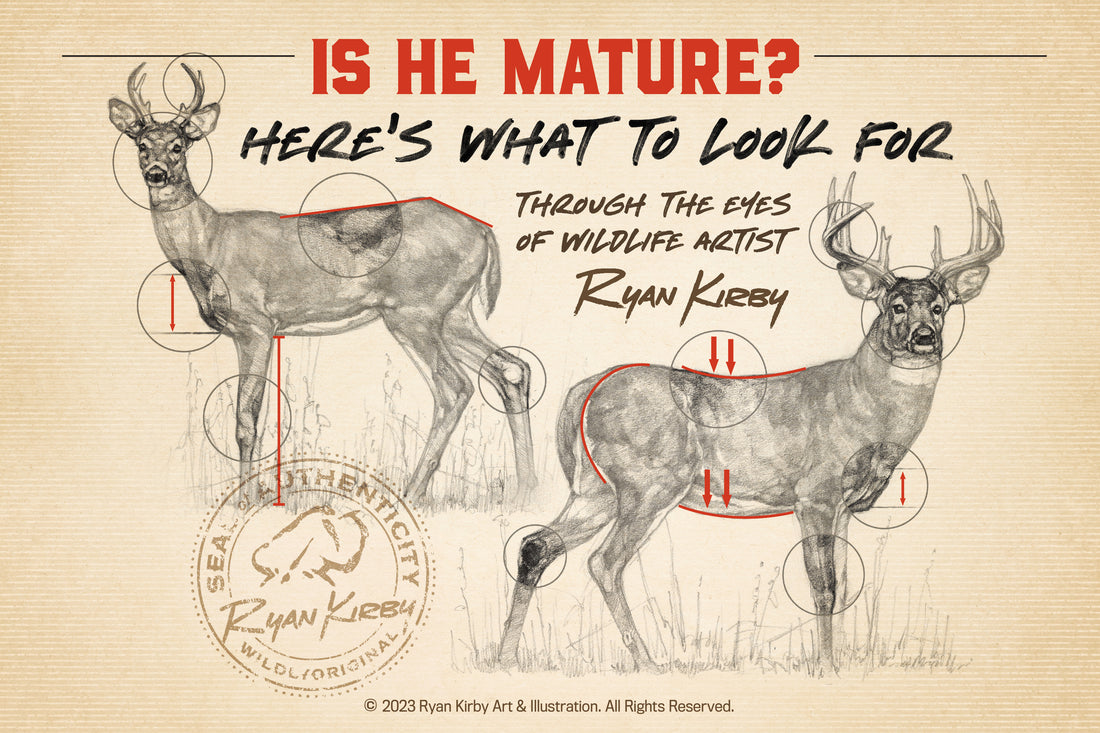As an artist and bowhunter, I’ve spent my entire career studying the characteristics and behavior of white-tailed bucks to paint and hunt them. These passions came together in my best-selling print “The Growth & Maturity of the White-tailed Buck," featuring an in-depth look at each year of a buck's growth cycle.
The finer points of aging a buck on the hoof come into play when you have years of history with a specific deer, or have lots of time to study him. That doesn't always play out in a deer stand though, when a buck suddenly appears. So here’s what to quickly look for in the field to quickly determine if the buck you’re looking at is mature or not.

GROWTH
[1.5 AND 2.5 YEAR BUCKS]
SMALL ANTLERS: The obvious sign of a young buck is a small rack. At 1.5 years old, he’ll likely sport headgear that ranges from spikes to a “basket” rack of 6-8 points. The first two years of his life, most of his energy is devoted to skeletal growth, and he simply can’t spare any extra energy for body mass. (If you’ve ever seen a teenage boy eat 6,000 calories a day and not gain a pound, you get the idea.)
“LONG” FACE: He looks like a doe with antlers. That’s how most hunters would describe a young buck. His head appears long, lean and pointy, just like his momma.
THIN NECK: A young buck’s pencil thin neck further accentuates his doe-like appearance. He’s yet to participate in the rutting activities that demand a swollen, muscular neck. As a result, his neck will connect to his body far above the brisket.
SCRAWNY SHOULDERS: From a broadside view, their hind quarters appear larger than their shoulders. If you imagine picking them up from the middle, a young deer would appear to tip over backwards.
STRAIGHT BACK AND TIGHT BELLY: Wouldn’t it be great if we could get that youthful metabolism back? There’s no sag in that belly or his frame, he’s just a lean, mean immature machine.
ANGLED RUMP: A young buck’s rump is lean, angular and appears larger than the shoulders when broadside. It also has a “jacked up” appearance, as if his hind legs are longer than his front ones.
“LONGER” LEGS: His legs aren’t actually longer, it’s just appears that way because he’s yet to fill out. A young buck appears awkward and gangly, especially when seen cruising across a wide open field during the rut.
LIGHT TARSAL GLANDS: During the rut, bucks will rub urinate on their tarsal glands, which involves rubbing their hocks together and urinating on them. This stains the glands darker with each passing year. Since young bucks are rookies to the rut, they’ve yet to stain their glands like older bucks.
LIGHT RUT PARTICIPATION: Many factors will determine just how much a young buck will participate in the rut – mainly, it’s whether there’s an older buck around. Research has shown that yearlings and 2.5-year-olds will combine to sire about 33% of the fawns in populations with good age structure. Young bucks can and do get their shot, but will almost always lose out if an older, larger buck is in the area.
Did You Know? Research shows that 50-75% of 1.5-year-old bucks will disperse an average of 1-5 miles to establish their own range after leaving their mother.

MATURITY
[3.5+ YEAR OLD BUCKS}
LARGE ANTLERS: At around 2.5 years of age, a major shift happens inside of a white-tailed buck: his skeleton stops growing. From here out, he can devote more resources to antler growth and body mass. He may never be a giant (that’s largely determined by genetics), but with good nutrition and age, he’ll make gains each year. Of particular interest to hunters is that at 5.5 years old, he’ll typically sport the largest rack of his entire life. Most whitetails entered in the B&C Record Book are 5.5 years old.
“SHORT” FACE: His head appears short at profile and may begin to exhibit a “Roman” nose. His muzzle begins to gray and his forehead dark. Older bucks may develop sagging underneath the chin.
SWOLLEN NECK: His neck is massive, powerful and connects to the body just above or at the brisket. A tell-tale sign of a very mature buck is that his neck and brisket are almost seamlessly connected in one smooth, continuous mass.
FULL SHOULDERS: One easy clue to a buck’s maturity is to compare his rump to his shoulders. If his shoulders appear larger than his rump from a broadside view, he’s entered maturity and will continue to gain mass in this area as he ages.
SAGGING BACK AND BELLY: It ain’t beer, it’s just gravity. Over years of adding weight to his mid-section, bucks often develop a noticeable sag in the back and stomach.
ROUNDED RUMP: He’s got some junk in the trunk. A mature whitetail’s hind quarters are full and rounded compared to the lean, angled rump of his youth.
“SHORTER” LEGS: These legs aren’t shorter at all, it’s just that his body mass has increased so much that the legs appear shorter.
DARK TARSAL GLANDS: A mature buck’s tarsals are large and dark, with stains often reaching all the way down to the hoof. This is the result of years of rub urinating on them during the rut. In some old bucks, the hair is scalded completely off the leg below the tarsal glands.
HEAVY RUT PARTICIPATION: Mature bucks compete heavily with rivals and come hell or high water, he’ll breed as many or more does than he did the previous year. Most times a mature buck’s body and antler size will deter smaller bucks without an actual fight. But if two aggressive bucks in similar age classes square off in a battle for dominance, look out – you’re in for a show.
Did You Know? A buck is still considered to be in his prime until he reaches around 8.5 years of age, at which point his body, antler size, activity and dominance begin to decline. Deer in the wild are capable of reaching ages upwards of 15 years old, but almost never older than 20.

As an artist, it’s my passion to enhance the atmosphere of deer camp. The best way I know to do that is through my best-selling paper prints “The Growth & Maturity of the White-tailed Buck" and “The Anatomy & Physiology of the White-tailed Buck.” The above art and information (plus much, much more) can be found in one place that you can hang on the wall. It’s been an honor to produce them, and I guarantee you they’ll be the talk of hunt camp!
Wishing you a successful deer season,

Get my two most popular prints for 25% off in the Art of Hunting Bundle!



